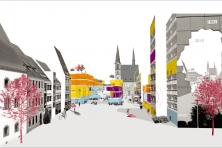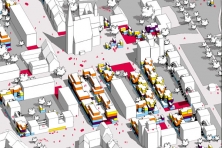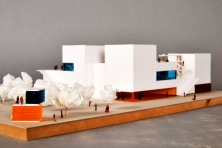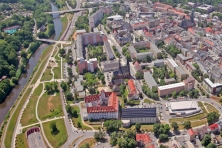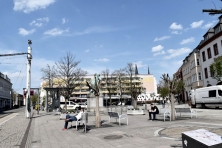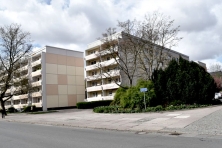Connect Four
Zwickau (DE) - Runner up
TEAM DATA
Team Representative: Jurek Fahrenholt (DE) – architect
Associates: Valeriya Sidorenko (KZ) – architect; Anna-Lena Horn (DE), Pia Müller (DE) – landscape architects
jurek.fahrenholt@fh-erfurt.de
See the complete listing of portraits here
See the site page here

V. Sidorenko, A.L. Horn, P. Müller & J. Fahrenholt
INTERVIEW
Click on the images to enlarge
1. How did you form the team for the competition?
"Connect Four" is a team of Master's students in architecture and landscape architecture. The participation in Europan 14 was the first collaboration and part of an interdisciplinary project at the Fachhochschule Erfurt (Altstadt, DE). During a workshop of two days we found that we get on well with each other on a personal as well as on a professional level.
2. How do you define the main issue of your project, and how did you answer on this session main topic: the place of productive activities within the city?
The main focus was put on the avoidance of the current monofunctional use and unscaled, undefined problem areas within Zwickau's eastern inner city. This is solved with our 4 impulses productive, educational, social and living by creating a framework for a mix of uses. The result is a flexible modular system of "city bricks", which leads in combination with the impulses to different scales and appeal to varying resident groups. The use of old panels endows identity and animates residents to become activists of their own city and participate in the big process. In the long term the application of the four impulses and the integration of the residents lead to productive activity within the city.
3. How did this issue and the questions raised by the site mutation meet?
The existence of the platten is not the decisive question, but rather the handling of these. For this reason the main problem has been changed to the main potential by transforming the platte carefully. Consequently, the city centre was not completely converted, maintaining its identity and ensuring productivity and activity.
4. Have you treated this issue previously? What were the reference projects that inspired yours?
"Haus Neumann" by Peter Grundmann served as an inspiration for the idea of the transformation of the Plattenbauten. He uses “Resträume” and revives them by creating a network of fragments and thus creating a dialogue between the old and the new. Another important inspiration in the development of the concept was the basic principle of landscape urbanism by James Corner and Co. Important prerequisites like processes over time, flexibility, adaptability and site-specific working were considered and used. To wrap up these approaches, the idea of a board game arose. For one, inspired by a simple modular system like Lego Bricks and a set of rules which is part of every game, was decisive. A modular, structured system was created. The individual components may be combined freely.
5. Urban-architectural projects like the ones in Europan can only be implemented together with the actors through a negotiated process and in time. How did you consider this issue in your project?
The problem associated with the site is so complex that it cannot be solved with a single approach. A flexible, modular system is needed, which supports an open process to optimize eastern Zwickau piece by piece. Therefore, it was important not only to employ a purely architectural approach, but in particular to focus on the urban aspect, in combination with the actors in it. The proposal is understood as an open process, sensitive and sustainable to a changing context and the interaction between urban agents.
6. Is it the first time you have been awarded a prize at Europan? How could this help you in your professional career?
It is the first time we have been awarded a prize at Europan and for some of us this has been also the first time taking part in a competition. We are all very proud and believe that it will be a good start for our career.
